
Carex is a vast genus of more than 2,000 species of grass-like plants in the family Cyperaceae, commonly known as sedges. Other members of the family Cyperaceae are also called sedges, however those of genus Carex may be called true sedges, and it is the most species-rich genus in the family. The study of Carex is known as caricology.
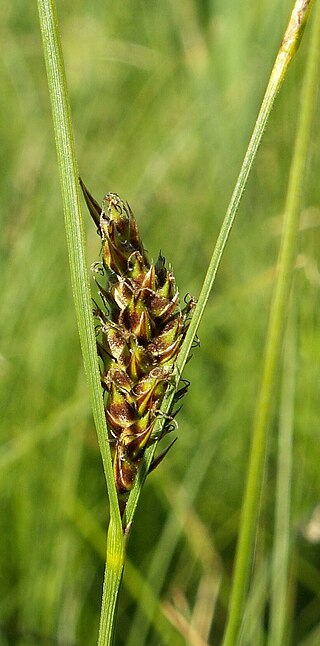
Carex lasiocarpa is a broadly distributed species of wetland sedge sometimes known as woollyfruit sedge or slender sedge. It is considered a species of Least Concern by the IUCN Red List due to its extensive range with many stable populations.
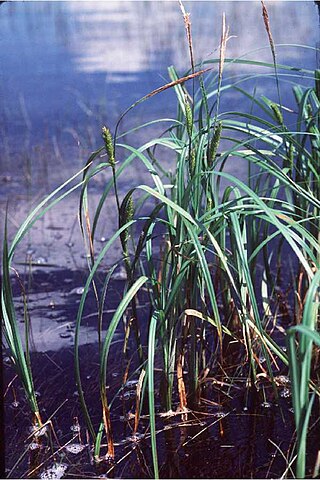
Carex atherodes is a species of sedge known by the common name wheat sedge. It is native to Eurasia and much of North America including most of Canada and the United States. It is a very common wetland plant across the American Midwest and areas west. It grows in moist and wet habitat, such as marshes and moist prairie land, and it may grow in shallow water. This sedge produces triangular, hollow stems 30 to 120 centimeters tall. The leaves are hairy, especially on the lower parts, and the leaf sheath is tinted with reddish purple. The inflorescence is up to 60 centimeters long and made up of several spikes; those spikes near the tip are usually staminate, and those lower in the inflorescence are usually pistillate. The tip of each fruit has two or more long, thin teeth.

Carex nebrascensis is a species of sedge known as Nebraska sedge.

Carex obnupta is a species of sedge known by the common name slough sedge. It is native to western North America from British Columbia to California where it grows abundantly in wet, often saline habitat such as wetlands. The plant produces upright, angled stems approaching 1.2 meters in maximum height, growing in beds or colonies from rhizome networks. The inflorescence is a cluster of flower spikes accompanied by a long leaflike bract. The pistillate spikes and sometimes the staminate spikes dangle on peduncles. The fruit is coated by a hard, tough, shiny perigynium which is generally dark in color.
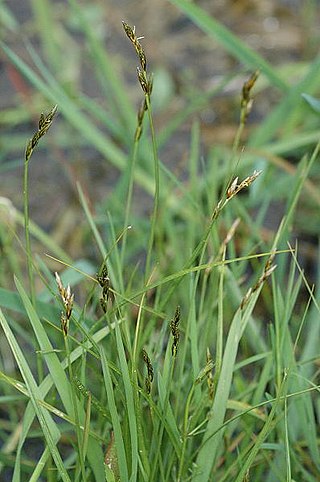
Carex leporina is a species of sedge known in the British Isles as oval sedge and in North America as eggbract sedge. It is native to Eurasia and eastern and western North America, where it grows in seasonally wet habitat, such as meadows and fields. This sedge produces many thin stems and narrow leaves. The inflorescence is an open cluster of several flower spikes. The pistillate flower has a reddish or brownish bract with a gold center and white tip.
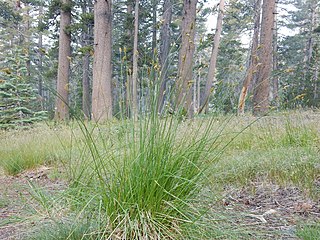
Carex pachystachya is a species of sedge known by the common name Chamisso sedge.

Carex rossii, commonly known as Ross's sedge, is a hardy species of sedge that is often a pioneer species in areas with little or no established vegetation, or in places where disturbance has occurred. Ross's sedge grows in a variety of habitats throughout much of western North America, from Alaska to Ontario, south to New Mexico and California. It flowers in May and June.
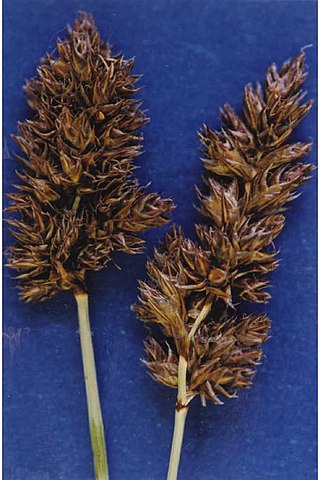
Carex simulata is a species of sedge known by the common name analogue sedge.

Carex pensylvanica is a species of flowering plant in the sedge family commonly called Pennsylvania sedge. Other common names include early sedge, common oak sedge, and yellow sedge.
Carex klamathensis is a rare species of sedge known by the common name Klamath sedge. It is known from 15 or fewer populations in southern Oregon and three populations in the Klamath Region of northern California. It was described to science only in 2007. Its habitat includes fens and other wet habitat, on serpentine soils. It was discovered independently by botanists Peter Zika and Lawrence Janeway.

Carex lutea is a rare species of sedge known by the common names golden sedge and sulphur sedge. It is endemic to North Carolina, where it is known only from Pender and Onslow Counties in the Cape Fear River watershed. There are nine populations. The plant was discovered in 1991 and described to science as a new species in 1994, and it has not been thoroughly studied nor completely surveyed yet. Its rarity was obvious by 2002, however, when it was federally listed as an endangered species.

Carex specuicola is a rare species of sedge known by the common name Navajo sedge. It is native to a small section of the Colorado Plateau in the United States, its distribution straddling the border between Utah and Arizona, and completely within the Navajo Nation. There are several populations but they are limited to a specific type of habitat. The plants grow from the sides of steep, often vertical cliffs of red Navajo Sandstone, in areas where water trickles from the rock. It occurs at elevations between 5,700 and 6,000 feet, usually in shady spots. Though it is not a grass, the sedge grows in inconspicuous clumps resembling tufts of grass sticking out of the rock face. When the sedge was federally listed as a threatened species in 1985, it was known from only three populations in Coconino County, Arizona, with no more than 700 plants existing. The species has since been observed in northeastern Arizona and San Juan County, Utah.

Carex pilulifera, the pill sedge, is a European species of sedge found in acid heaths, woods and grassland from Macaronesia to Scandinavia. It grows up to 30 cm (12 in) tall, with 2–4 female spikes and 1 male spike in an inflorescence. These stalks bend as the seeds ripen, and the seeds are collected and dispersed by ants of the species Myrmica ruginodis.

Carex inops is a species of sedge known as long-stolon sedge and western oak sedge. It is native to northern North America, where it occurs throughout the southern half of Canada and the western and central United States.

Carex distans, commonly known as distant sedge, is a plant species in the sedge family, Cyperaceae. It is native to Europe and North Africa. It is part of a complex of similar species that occur across Eurasia. Its relatives include Carex diluta of central Asia, which has also introduced to North America in Montana. C. distans has been introduced to US states including Maryland and Pennsylvania. More recently, it was found in Oregon. There is a report from Victoria, Australia as well.

Carex subg. Carex is a subgenus of the sedge genus Carex. It is the largest of the four traditionally recognised subgenera, containing around 1400 of the 2000 species in the genus. Its members are characterised by the presence of one or more exclusively male (staminate) terminal spikes, quite dissimilar in appearance from the lateral female (pistillate) spikes below. In most species, the female flowers have three stigmas, but a few species, including Carex nigra, have female flowers with only two stigmas.
Carex lemmonii, or Lemmon's sedge, is a plant in the sedge family, and is endemic to California. Carex albida is now considered a synonym, but was previously thought to be a separate species; such plants have the common name white sedge.

Carex eburnea, known as ivory sedge, ebony sedge, and bristleleaf or bristle-leaved sedge, is a small and slender sedge native to North America, from Alaska and Newfoundland south to central Mexico.

Carex blanda, the common woodland sedge or eastern woodland sedge, is a sedge native to a wide variety of habitats in the eastern and central United States and Canada.


















